Cholistan Desert
If you are searching for a desert safari in Pakistan, the Cholistan Desert is the place to go. One the largest deserts of Pakistan, the Cholistan Desert, is a magical place that offers a lot more than loose dust and the sun’s scorching heat. The forts built in historical times, the remains of old rivers, and the conventional style of the people living there will be a trip back into the past.
You will find herds of camels and listen to the bells hanging on the cows. The old archaeological sites will show a glimpse of the past and the antic experience in the wild.
History of Cholistan
Cholistan Pakistan is a desert now, but long ago, it was home to many Indus Valley and Harappan civilizations. Two great rivers, Sutlej and Yamuna, ran through this area from 4000 BCE to 600 BCE, supporting the settlements on its banks. The dry Hakra river bed can still be found in this area.
Archaeologists found around 450 settlements in Cholistan during their research in 1990. The remains of these settlements show that the area was largely populated and most productive in its time. It became a part of the Cemetery H culture that began as a result of the survival of Harappan culture.
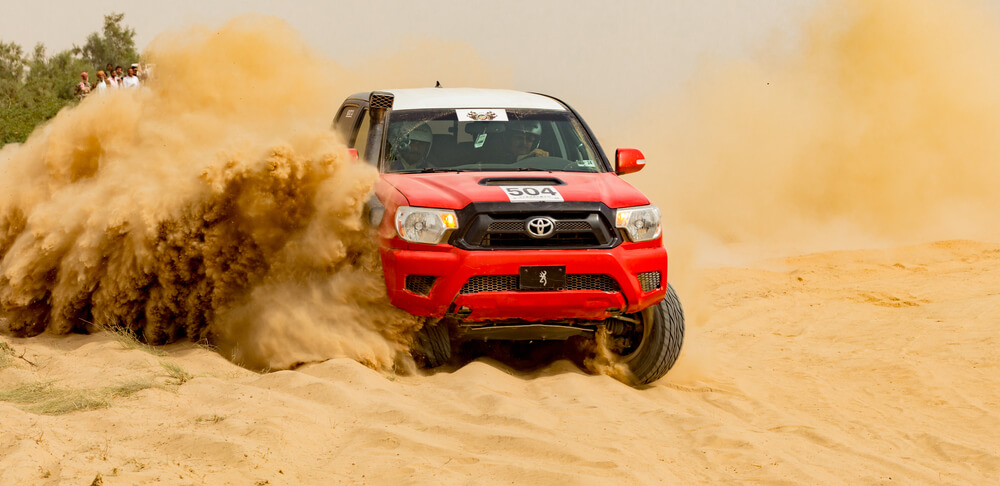
The area later became the hub of the caravan trade, leading to the building of a series of forts during medieval times. The forts are suggested to be on the UNESCO World Heritage Sites list.
Cholistan Desert Weather
Cholistan is an arid and semi-arid Tropical desert where rainfall is highly scarce. The average temperature of the area is 28.33 °C. July is the hottest month when temperatures can sometimes rise over 50 °C.
Winters in the desert can sometimes be freezing, with occasional sub-zero temperatures. Nighttime can especially become chilly. The average rainfall received in Cholistan is 180mm, and it mostly rains in July and August. Droughts are widespread, and water resources are always insufficient.
Cholistan Desert Geography
Cholistan Pakistan is spread over a wide area, enveloping the cities of Bahawalpur, Bahawalnagar, and Rahim Yar Khan in Southern Punjab. The desert is spread over about 480 Km in length and varying width from 32 Km to 192 Km.
The location on the world map is 27°42΄00΄΄ to 29° 45΄00΄΄ north and 69°57′ 30’′ to 72° 52′ 30’′ east. The area is categorized as desert as over 80% of the land is sandy while the remaining 20% is covered with flat alluvial lands where vegetation can be found. The foliage is poor owing to low rainfall and wind erosion of the entire land.
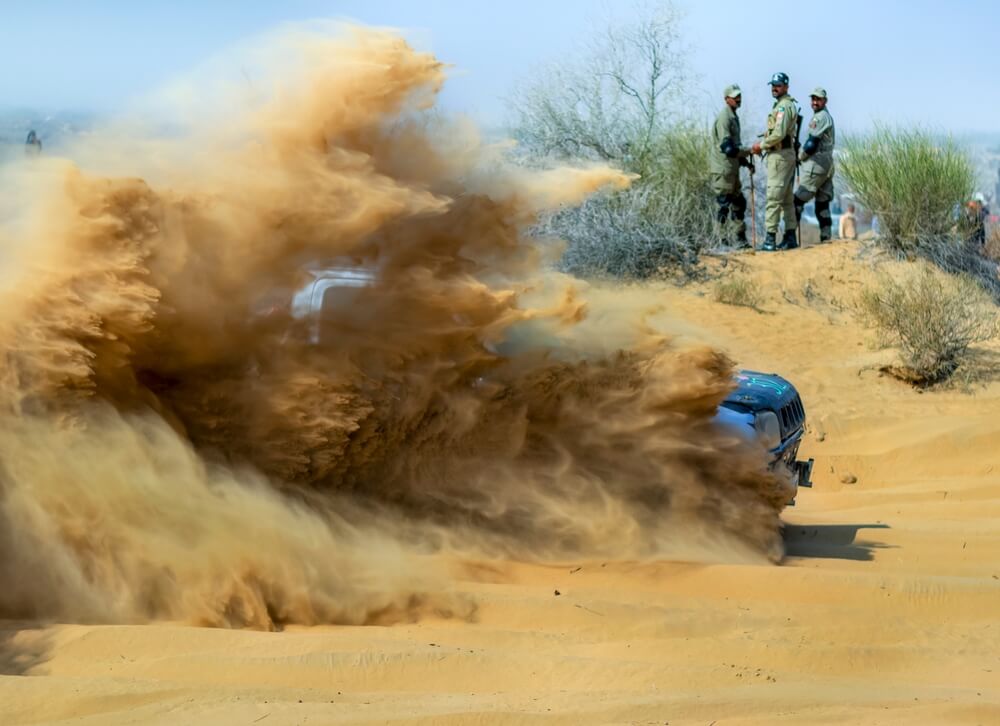
Cholistan Pakistan is a segment of the greater Thar Desert, extending from Punjab to Sindh and the Indian state of Rajasthan.
What is the Meaning of Cholistan?
Locally the desert is known as Roohi. Cholistan derives from the Turkish word chol, meaning “sands,” and “Istan” is a Persian suffix meaning “land of.”
Another popular opinion is that the desert got its name from the word “Cholna,” which means moving, pointing to the nomadic way of life led by the locals.
What Should be Packed to Visit the Cholistan Desert?
You will not need to pack plenty of things when visiting Cholistan. You’re good to go with just a few basic supplies in a rucksack. To avoid direct sun rays, don’t forget the sunscreen. You must rub it all over your exposed body to prevent sun tanning.
Keep an insulated water bottle to keep yourself hydrated in the extreme heat of the desert. Wear loose clothes which cover most of the body to prevent sunburns. You will find people of Cholistan wearing long robes as it protects them from the sun. Sunglasses and a cap must be seen clearly in the bright sun. Keep an umbrella for shade from the sun as you move. Also, keep a light sheet to spread on the ground to stretch out for a few minutes after a good hike in the dunes.
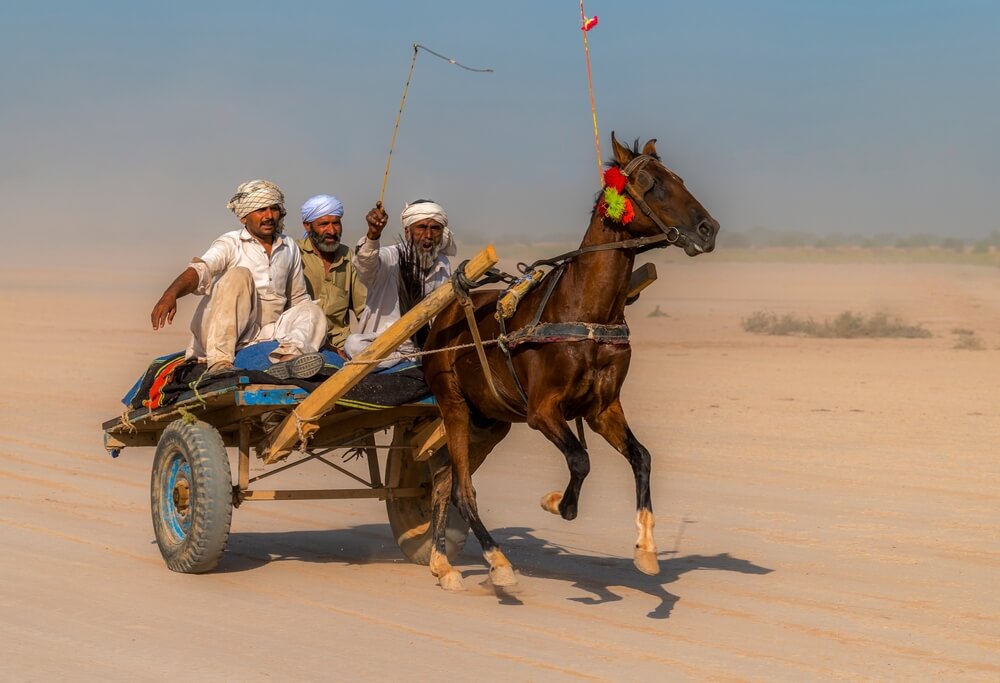
Pack some extra snacks to munch on while visiting the famous sites and a packet of wipes, as water will not be available everywhere, and you might need to clean yourself. An icebox filled with ice cubes will be essential to provide cold water in the hot desert. Lastly, extra shoes and clothes will be helpful if the sand gets into your clothes or shoes, which can be highly uncomfortable.
When is the Best Time to Visit the Cholistan Desert?
The weather in Cholistan can be extremely hot or freezing. The best time to visit this fascinating place will be in spring, from February to April. During this time, the weather is suitable when most events are organized in the desert. Tourists can also experience the diverse communities that are located there.
Places to Visit in the Cholistan Desert
The home of many Sufi poets and saints, Cholistan is where various cultures can be found. You can see the nomads dressed in their vibrant and colorful gowns. The place has festive vibes. The gorgeous desert has many forts and remains of old civilizations that would give you an insight into historical times. Let’s discuss some popular spots whose marvels will mesmerize tourists.
Derawar Fort
A Hindu ruler, Rai Jajja Bhatti, built the Derawar Fort in the 9th Century AD. The massive Derawar Fort is located 130 Km away from Bahawalpur. The fort has forty mighty cylinders, going along a perimeter of 1,500 meters. The enormous fort leaves the visitors stunned to think of how they were built long ago without machinery.
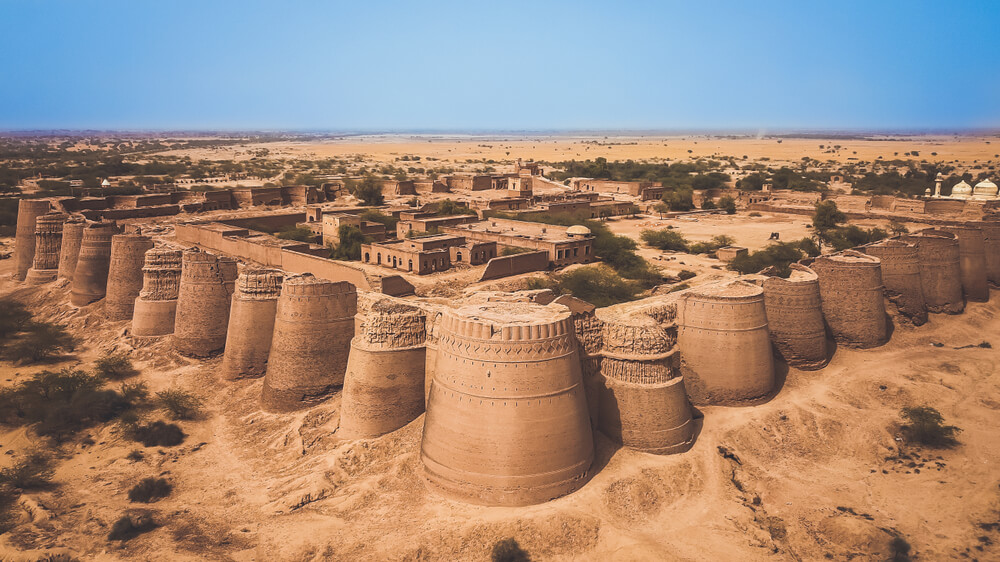
The fort was initially known as Dera Rawal, but the name changed to Derawar. The current structure of the fort was erected in 1732 and has not changed its form since then. The tour of this magnificent site will be an unforgettable experience.
Shrine of Chanan Pir
The Cholistan Desert has rich historical roots connecting many Sufi poets and saints. One such Sufi Chanan Pir is very significant to Hindus and Muslims in the area. A shrine has been constructed where he is buried, and the village is named after him.
The shrine is located between Din Garh and Derawar Fort. Many Hindu and Muslim devotees visit the shrine regularly. A Urs is held annually, where thousands of people come to pay their respects from all over the region.
Abbasi Mosque
Many mosques were built by the Nawabs and rulers around the 19th century. Abbasi mosque is close to Derawar Fort in Yazman Tehsil in the Bahawalpur district. Nawab Bahawal Khan built the mosque.
The mosque has three massive domes in the main building, and one is made at the entrance. The mosque has four striking minarets and is said to be built on the same design as Moti Masjid in Lahore fort. The mosque can simultaneously accommodate up to a thousand people in its hall and a vast courtyard.
Royal Graveyard
You can experience the royal artwork and architecture presented at Royal Graveyard. The Abbasi Family ruled Bahawalpur as Nawabs. The family members are buried in the royal graveyard a few yards away from the Shahi Derawar Masjid. Currently, the living members of the Abbasi family take care of the cemetery where their ancestors are buried.
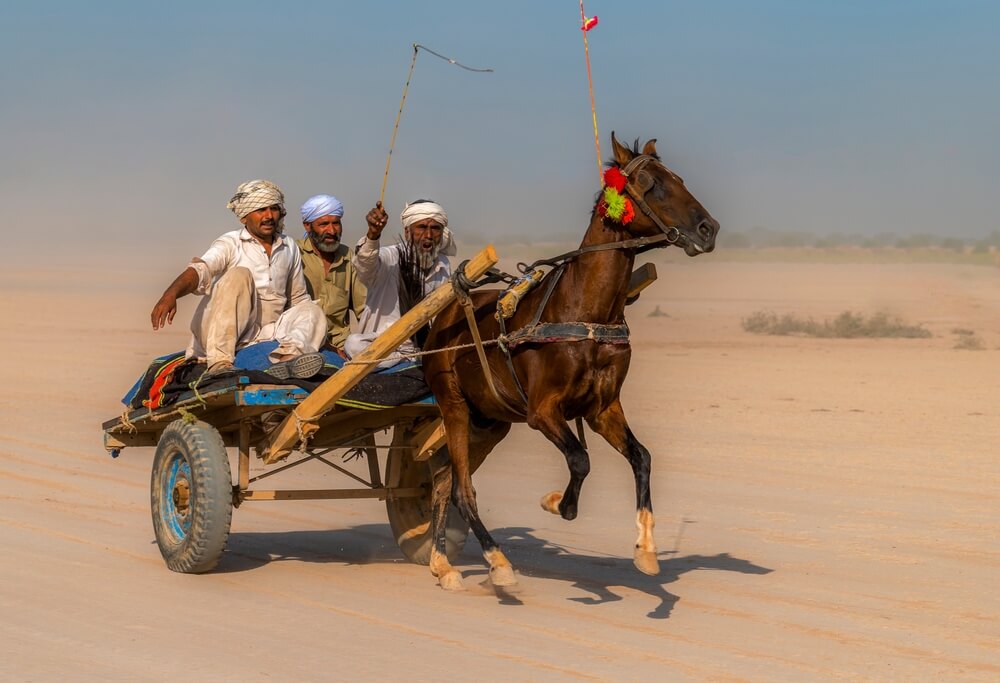
There are twelve graves of the rulers of Bahawalpur in one rectangular room. The single tombs belong to the rulers’ wives, sisters, or brothers.
The eyes will be set on the great architectural beauty these tombs display. You will be fascinated by the immaculate blue paintwork that is Sindh and Punjab’s signature form of artwork.
Dodhla Forest Cholistan
Amaze yourself by taking a tour of one of the underestimated places in Cholistan, Pakistan, the Dodhla forest. A preserved rainforest in Pakistan inhabits a large variety of flora and fauna. It may sound too good to be true about its presence in the desert, but a few areas receive water supply which supports the growth of places such as this.
Things to Do in the Cholistan Desert
You will find several activities to do during your visit to the beautiful Cholistan Desert. The tour can be thrilling and adventurous with unforgettable experiences. Let’s take a look at some of the exciting activities to do in Cholistan.
Camel Safari
You can book any local tour for a camel safari and experience the life of a nomad. The unique time will begin in Bahawalpur. The camel ride starts from Yazman and Chanan Pir. Spend a couple of nights camping under the sky and visiting the famous cultural and historical sites of Derawar Fort, Uch Sharif, a mystic center of Punjab, and visiting the Abbasi cemetery and Abbasi mosques.
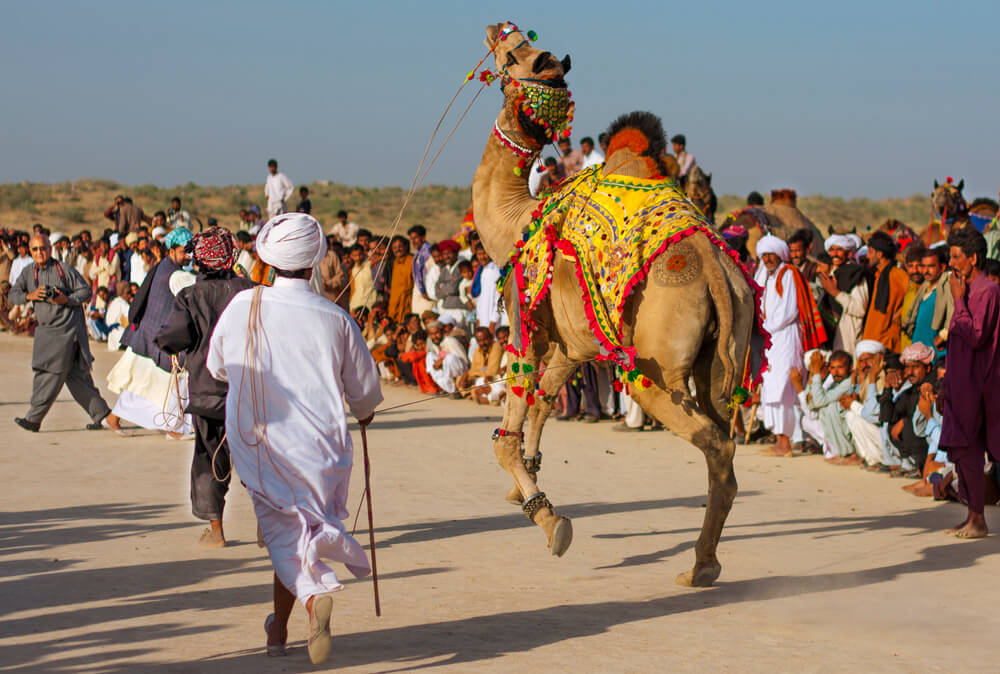
The tour guides will take you to visit the significant villages on camelbacks to see their culture and lifestyles. The tour guides provide the meals. You will witness some nomadic settlements that have made their temporary shelters out of straw.
Bonfire with a Barbecue at Night
The best way to experience the exceptional desert is to spend a night there. Many people go to Cholistan for a night stay. Join them to have company and enjoy their food and music.
The sunset in the desert will steal your heart as the colors split into a thousand shades of violet, pink, and blue before the darkness takes over. Remember to take all food and cooking supplies with you. Light up the fire as it gets dark, and have fun as you sing songs with your friends and feast on the hot barbecue. Warm up in the chilly desert night and remember to leave no traces of the trip for minimal impact on the land.
Camping under Starry Sky
The desert sky will leave you spellbound. The galaxy will glitter with millions of stars above your head, and you might be fortunate enough to see a falling meteor. The nighttime in the desert gives the perfect opportunity to spot the Milky Way. The serenity embedded in the desert’s silence is unmatched by any other place.
International Level Cholistan Desert Rally
Pakistan has been hosting exciting events for the nationals, which also attract international participants. The adventurous International Level Cholistan Desert Jeep rally started in 2005 and grew successfully with each passing year. The jeep race is organized by Pakistan tourism development Corporation.
The event portrays a positive image of Pakistan internationally while promoting tourism for people abroad. Such events support local businesses and demonstrate the rich history of Cholistan to those abroad.
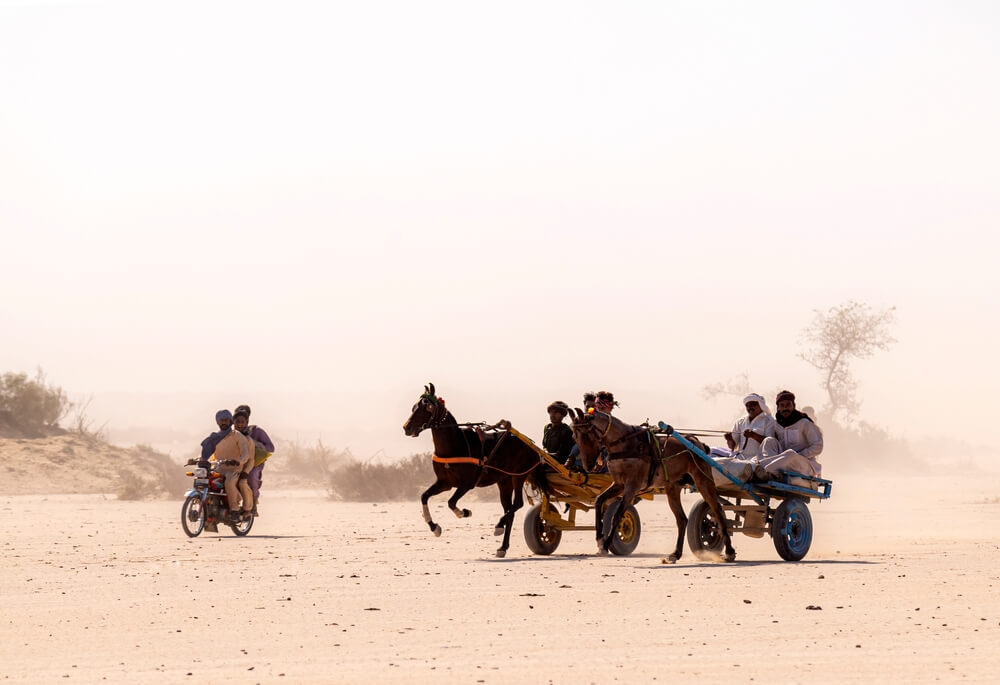
The rally is divided into the Stock, Prepared, and Women categories. This year’s event took place in February for five days, when the weather was pleasant and suitable. The event invited more than 100 races from the whole country, and over 100,000 tourists came to participate as spectators.
The rally route is nearly 500 Km long, and it starts from the Derawar Fort, covering the regions of Bahawalpur and Bahawalnagar. There is a paragliding competition and dirt bike competition conducted during the event. If you don’t wish to participate in the races, you can visit Cholistan as a spectator to watch the remarkable desert rally in our country.
What is Cholistan Famous for?
The arid region of Cholistan has many attractions despite being a part of the desert. The forts and ancient sites make Cholistan an ideal place for curious travelers who love to explore. The area is well known for the camel races. Among the many forts there, the Delaware fort is the most famous. You can explore other forts in the area, such as Islamgarh fort, Mirgarh fort, or Margot fort.
Economic Importance of the Cholistan Desert
Cholistan is the hub of handmade crafts that are popular worldwide. The textile craft produced by women in the region is valued worldwide. Originally stemmed as a necessity, their textiles later became a hallmark of Pakistani products. The Ajrak is a unique kind of block print on cotton in indigo, blue, and red colors.
A special kind of material, Khaddar, is made for their use, but their products in the form of bed covers and lungies or skirts are sold in markets too. They make beautiful cloth out of silk and cotton wool, known as Sufi. It is used to make Gagras in vibrant colors adorned with mirror work, delicate patchwork, and embroideries. You will not be able to resist buying colorful spreads or frames during the trip.
The area produces some best quality wool from which carpets are made. These are superior in quality to those produced anywhere else in the country. The thread knits excellent rugs, blankets, carpets, and other woolen products. The nomads earn good revenue by selling wool in different areas.
Rearing livestock is the primary source of economic activity in Cholistan. The unavailability of water supply does not allow the locals to undertake agricultural farming. Camels are the most prized possession for the people as it provides them with milk and meat and as a mode of transportation. The two kinds of the camel found in the region are Marrecha and Barella. Marrecha is used for riding or for dancing during festivals. Barella is used for milk, producing 8 to 9 liters of milk per day.
How to Reach the Cholistan Desert?
The closest city to Cholistan is Bahawalpur. You will have to reach Bahawalpur to go further into the desert. You can travel to Bahawalpur by train, car, and bus or catch a local airline from any city in Pakistan.
From the city, many buses or tour operators can take you to the dunes. You can choose to stay in the city or hire tour guides to arrange camps in the desert.
Location of Cholistan Desert
The majestic land of Cholistan is a part of Southern Punjab. You can see Cholistan on the map extending from Punjab to Sindh. It is also the largest desert in Pakistan, situated 30 Km from Bahawalpur, spreading over an area of 25,000 Km. The unique feature of this desert is that it is split between Pakistan and India. The other segment of the desert is in the Rajasthan province of India.
FAQs
How many forts are there in the Cholistan Desert?
There are 29 forts in the Cholistan Desert.
Which animals are found in the Cholistan Desert?
You will find sheep, camels, and cows in the Cholistan Desert.
How do people survive in the Cholistan Desert?
The people survive the intense heat of the desert by wearing loose clothes and living in huts made of mud and straw. They rely on their livestock for food and a source of income. You’ll find the nomads staying where they can find an oasis as a water supply to fulfill their necessities.
What is the local language of the Cholistan people?
The local language of the Cholistan people is Saraiki.
How Much is the Total Area of the Cholistan Desert?
The desert is spread over an area of 25,000 Km.
Who won the Cholistan Jeep Rally 2022?
Mir Jaffer Magsi won the 17th international jeep rally from Lahore. He completed the 221 Km long track in only four hours, 10 minutes, and 51 seconds.
Conclusion
The northern part of Pakistan takes all the attention of local and international tourists. Explore the deserts, and you will be surprised by the natural treasures owned by the country waiting to be discovered and cherished. The historical remains will transport you to times when life was very different. A trip to Cholistan will be worth it.
